There’s good news for bicycle purchasers: A constantly growing market and vigorous competition have kept prices low. Dollar prices for good-quality bicycles have hardly risen since the first edition of this guide was published in 1973, even though the dollar was worth twice as much back then.
Also, the variety of bicycles and accessory equipment available has increased enormously. Here’s a list of products which were unknown, or high-priced rarities only a few years ago: all-terrain bicycles, sturdy BMX bikes for children, helmets, high-performance nylon-cord tires, lightweight aluminum cranksets, wide-range hill-climbing sprockets, rechargeable-battery lights, reflectorized clothing, Gore-Tex rainwear, and specialized bicycle clothing and shoes. Today you can buy these products at any bicycle shop. This trend can be expected to continue.
This section will get you started with the information you need to buy the right bicycle and the accessories necessary to use it well.
TYPES OF BICYCLES
Six principal types of bicycles are sold for adult use:
• The one-speed “tank” or cruiser bicycle, heavy, with wide tires, flat handlebars, and usually a coaster brake. (For safety in traffic, it should have a front handbrake as well.) Cost: $60—$200.
• The utility bicycle, such as the English three-speed, with moderately wide tires, handbrakes, and fenders for wet-weather riding. Some utility bikes, with wider tires, are upgraded “cruiser” bicycles with five or six speeds. Cost: $80—$300.
• The lightweight multispeed bicycle, with dropped (ram’s-horn-shaped) handlebars and narrow tires. This category subdivides into “sport” bicycles, with a short wheelbase for quick maneuvering, and “touring” bicycles, with a longer wheelbase and lower gears for comfort. Cost: $1 00—$1 500.
• The multispeed all-terrain bicycle or “mountain bike,” which combines the durability and surefootedness of the “tank” bicycle with sporty performance and the ability to climb steep grades easily. Cost: $250—$1500.
• The small-wheeled folding bicycle, which falls some what short in performance, but is the best if you wish to travel with your bicycle or if storage space is limited— For example, in a city apartment. Cost: $150—$400.
• Specialty machines. This category includes tandems, track-racing bicycles, recumbents, arm-powered vehicles, and more—machines with special features or for special uses.
One- and Three-speed Bicycles
It’s easy to think the more gears, the better. In the last thirty years, popular bikes have gone from one gear to three, then to ten, now to twelve, fifteen, and eighteen. But more gears don’t necessarily make a bicycle right for you.
One- and three-speed bicycles offer mechanical simplicity, durability, and low cost. They are adequate for short trips in moderate terrain, and less prone to theft if you need to lock your bike outdoors where you shop, work, or go to school.
The typical one-speed bike is designed to withstand the heavy punishment that a youngster or anyone using it for constant delivery or patrol work may give it. The frame is constructed of heavy-gauge steel, the tires are heavy-duty balloon type, and the braking sys tem is contained within the rear hub or possibly in the front hub, as with the internal-expanding brake-shoe type. For the most part, these bicycles require no external levers or cables. The standard version resembles the conventional bicycles commonly seen until the early 1950s.
Three-Speed Bikes
If you plan to travel short distances or use your bike only occasionally, a three-speed bicycle with internally geared rear hub and caliper brakes, costing less than $100, may be the answer. People living in the Midwest, or any other relatively flat area, will find that the three- speed bicycle meets their requirements. It can move along at a reasonable speed, with sufficient shift range for climbing moderate grades. Those who commute short distances may not need the more complicated equipment of the derailleur-equipped bike. Three- speed hubs are available with a built-in coaster brake or drum brake, useful in wet weather when rim brakes don’t work as well.
A five-speed internally geared hub is available. It has a wider gear range and closer spacing. For in-town utility riding and commuting, this offers all of the advantages of derailleur gearing without the disadvantages.
Internally geared hubs are rugged and weather- resistant. They shift instantly, even when the bike is stopped. For this reason, they are the ultimate for stop-and-go city riding. Also, the internal gear mechanism requires much less frequent maintenance than a derailleur gearing system.
Multispeed Bicycles
Multispeed bicycles allow you the full enjoyment of bicycling as a sport and recreation. With their larger number of gears and wider range, they can climb steep hills easily. After a couple of months’ practice, almost anyone can easily travel 50 to 100 miles per day on a road bike with dropped handlebars. An off-road bike, with its wide tires, is about 10 percent slower on good roads, but is surefooted on dirt roads, trails, and potholed streets, and more resistant to abuse—a plus for beginners.
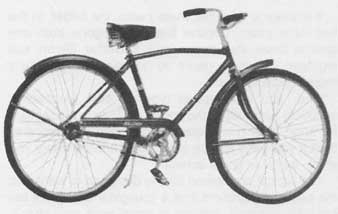
above: A typical heavy-duty bicycle with a three-speed internally geared hub
is suitable for short trips. It’s equipped with fenders for use in wet weather.
By turning its handlebars upside down and lowering the gear range, its performance
can be improved considerably.
A ten- or twelve-speed bike is suitable for most uses. Bicycle racers rarely use more than a twelve-speed bike.
A fifteen- or eighteen-speed bike gives you the widest possible gear range. It has real advantages for touring in hilly country and for off-road riding.
Narrow-tired road bicycles are sold in a wide range of prices. Generally, expect to spend $200 or more for a bicycle of good quality. At this price level, the bicycle will be equipped with aluminum rims and crankarms, the most effective way to save weight. A price will bring added refinements: more precise construction of components and a frame of somewhat lighter, stronger material. High-grade frames use light, thin-walled alloy steel tubing brazed into lugs, or welded. Butted tubing means the ends of the tube inside the lugs have a double thickness for added strength. As the price of the bike increases, the number of butted tubes in the frame increases; top-quality machines have butted tubes throughout. A decal affixed to the frame will proudly show that the tubing is Reynolds 531, Columbus, Ishiwata, Tange, or another high- grade brand. Increasing numbers of high-grade frames are made of even lighter aluminum, graphite fiber, or titanium.
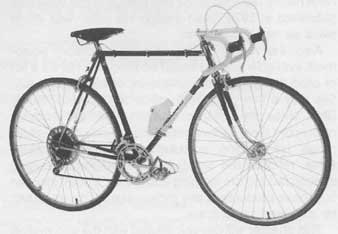
above: A typical multispeed derailleur-geared bicycle with dropped handlebars
offers high performance for longer trips.

above: A racing bicycle has a short wheelbase—note how close the rear wheel
is to the seat tube—and no low gears.
In the higher-quality ranges, road bicycles divide into two major categories, as mentioned above.
Sport bicycles are designed for high performance: quick maneuvering and acceleration, but at some expense in comfort, utility, and durability—like a sports car. The seat tube and head tube of the frame are more nearly upright to shorten the wheelbase. Usually, a sport bicycle has a narrow gear range, appropriate for racing and for riding without baggage. The tires are especially narrow, for low rolling resistance. There may be no mounting points for fenders or a baggage rack. Some sport bicycles make compromises to be more useful for all-around riding; at the other end of the scale are the out-and-out racing bicycles.
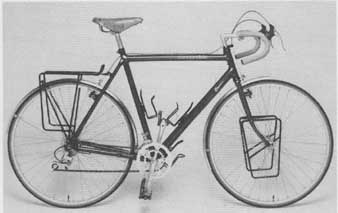
above: Touring bicycles are designed for long-distance travel with or without
baggage. The seat tube and head tube are less upright than those of a sport
bike, for a smoother, more comfortable ride. The wide gear range makes it easier
to climb long grades, even while carrying full camping gear. Fifteen- and eighteen-gear
systems are common on touring bicycles. Tires are of moderate width, and the
wheels are sturdy enough to carry the rider plus baggage.
The wide tires of the all-terrain bicycle are not the only way it’s different from a road bike. The top tube of the frame is lower, for easier mounting and dismounting. The crank spindle is higher, for more ground clearance. The long wheelbase and wide handlebars give sure, steady handling. The gearing is lower; the best all-terrain bicycles, like the best touring bicycles, have fifteen or eighteen gears. The inner chainwheel is extra-small for ease in climbing steep slopes.
The touring bicycle has a long wheelbase, an ultralow gear, shallower head-tube and seat-tube angles, and racks and fenders. This and the preceding photograph are of bicycles with large- diameter, lightweight aluminum frame tubes.
A folding bicycle is practical transportation for the person on the go. Smaller folding bicycles can be packed as baggage and carried onto public transportation, making it possible to use the bicycle to make connections at both ends of a commuting trip. A folding bicycle is ideal for use along with a car, boat, or air plane. As an example, when you leave a car off to be repaired, you can ride the folding bike home.
Folding-bike designs and prices vary widely. Two examples are illustrated here. The Hon is compact enough to fit under an airplane seat. The Moulton is less compact, but its performance rivals that of any all-around touring bicycle.
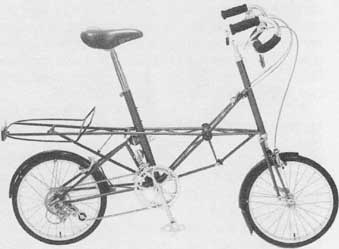
above: With its spring suspension, triangulated frame, derailleur gears, and
bolt-on baggage racks, the Moulton offers unusual comfort and touring-bike
performance, yet it comes apart for easy storage.
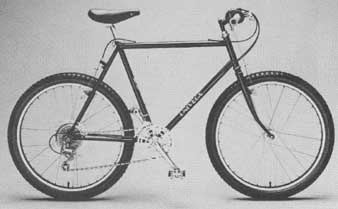
above:
The all-terrain bicycle is light in weight and has ultra-wide-range
gears. The wide handlebars and fat tires are ideal for rough ground.
Many bicyclists own more than one bicycle— typically, a multispeed bicycle for pleasure rides and a rugged, simple bicycle for short utility trips.
Specialty Bicycles
A good tandem is a fine experience for two people who like to ride together. On a tandem, two people of differing skill or strength can ride without becoming separated—a couple, or a parent and child. If you don’t have a regular partner for a tandem, owning one is a great way to meet people. Tandems are somewhat faster on level ground than solo bicycles, because the rear rider contributes little wind resistance.
It’s important to shop carefully for a tandem. It’s a big investment—$1,000 or more for a good one. Before buying a tandem, try one out to be sure that both riders will enjoy it. High quality is especially important in a tandem, because all moving parts must bear twice the load. A wide-range gearing system is necessary, be cause tandems go downhill fast and uphill slowly. Rider fit is also very important. Modern tandems tend to have a stiffer frame and more room for the rear rider, so they are the best choice unless the rear rider is small and light.
The track racing bicycle is designed for only one purpose, racing on a surface specially constructed for bike races. These machines are the ultimate in lightweight.
Track bikes have a direct-drive system from the chainwheel to the fixed rear sprocket, thereby eliminating the front and rear derailleurs, and their friction. This means that as long as the rear wheel is turning, the crank is also rotating; thus the rider’s legs are always in motion. The track bike does not have any braking system; the rider slows it by pushing back against the turning pedals.
Often, people get very excited about recumbent bicycles, because some of them have set speed records of up to 65 miles per hour. In order to do this, they must be equipped with a streamlined windshell which is very sensitive to side winds. A shell is impractical for everyday use, except on a three-wheeled vehicle. In fact, streamlined adult tricycles have been built, but they are not yet widely available. The most practical tricycle designs are not as fast as the record-setting machines, but they are much smaller and more maneuverable.
Recumbent bicycles without a windshell are widely available now. They are longer and so less maneuver able than a conventional bicycle; they are a little faster on level ground, but slower on hills. A recumbent’s most important selling point is comfort rather than speed. It does not put strain on the back and arms.
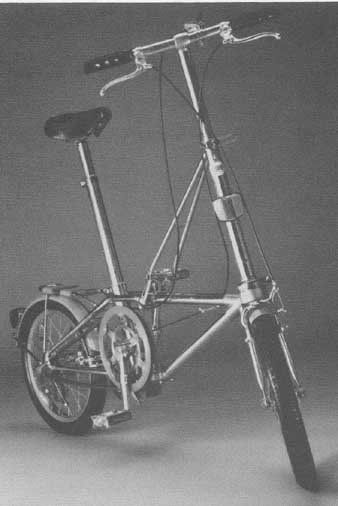
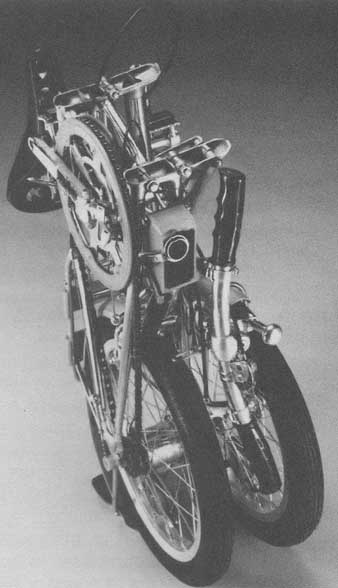
above: When folded, this Hon Convertible bicycle will fit under an airplane
seat. The folding bicycle sacrifices some riding performance, but is by far
the most practical to use in combination with a car or public transportation.
The tandem bicycle is an unusually good way for two people to ride together, or for introducing beginners to bicycling. A good tandem has heavy-duty components throughout, and ultra-wide-range
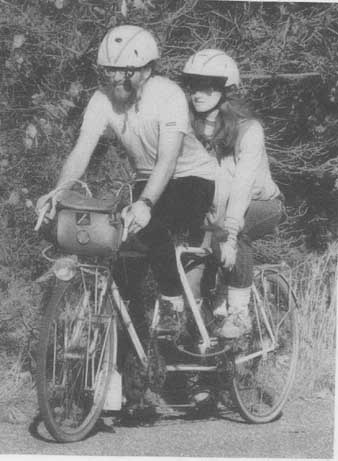
above: The tandem bicycle is an unusually good way for two people to ride together,
or for introducing beginners to bicycling. A good tandem has heavy-duty components
throughout, and ultra-wide-range gears.
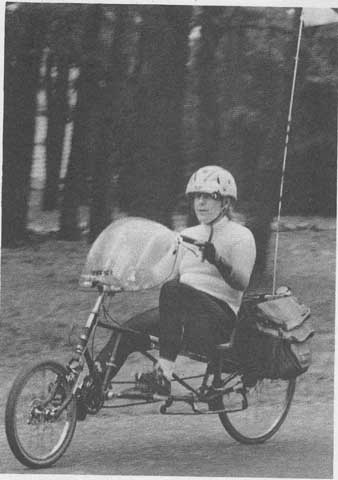
above: The main advantage of the recumbent bicycle is comfort; its performance
is about equal to that of a conventional bicycle.
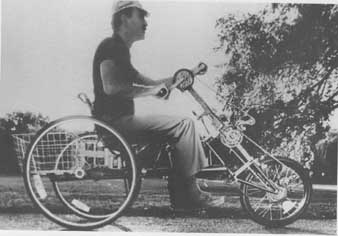
above: This hand-powered tricycle offers outdoor exercise and travel at bicycle
speeds to a person who cannot use the legs for pedaling.
Many people prefer a recumbent for these reasons. For other people, a recumbent is the only choice; a person who has a bad back or has lost the use of one arm has no problems at all in riding a recumbent.
Some manufacturers also maintain that a recumbent is safer. Surely, a fall is less likely to be serious; but a safety flag, as shown in the illustration, is important for visibility over a hillcrest or behind a car.
Even greater degrees of specialization are possible— For example, the hand-powered tricycle illustrated. This allows mobility at bicycle speeds for a person who cannot use the legs for pedaling.
Children’s Bicycles
Children’s bicycles have special requirements. Small children who ride tricycles are safer on the laid-back “Big Wheel” design; the traditional upright tricycle is top-heavy and unsteady.
As the name implies, sidewalk bikes, many of which are classified as toys, are intended for use only on the sidewalk and are built for tiny tots aged three to five. The least expensive models are rather dangerous be cause they don’t have brakes.
The more expensive sidewalk bike contains some solid material and better workmanship. A coaster-type brake is standard equipment, giving the child some control of stopping by applying pressure in a reverse direction.
Trainer wheels, which attach to the axle on both sides of the rear wheel, are available. However, considerable controversy exists as to whether they should be used or not. Many argue that the child will develop his balance and coordination more quickly if he is assisted by a parent or older brother when first learning to ride. A child can learn to balance without assistance on a scooter, or on a bicycle that has had its pedals removed and seat lowered so that both feet can touch the ground.
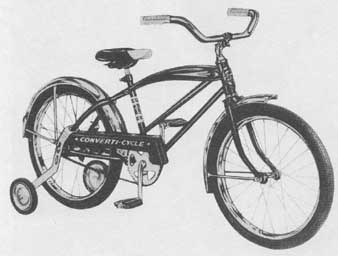
above: A typical sidewalk bicycle for a small child has 1 6-inch wheels and
a coaster brake.
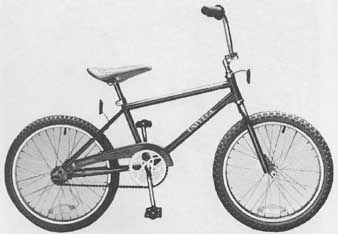
above: The true BMX (bicycle motocross) bicycle is rugged, to withstand a child’s
abuse and off-road riding. With its low saddle position and single gear, it’s
made to maneuver easily with the rider in a standing position. It’s not suitable
for travel beyond a mile or so.
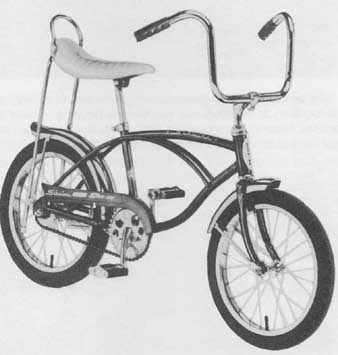
above: The “high-riser” child’s bicycle looks sporty, like a motorcycle, but
high handlebars and rearward rider position decrease its stability.
For a child eight to twelve years old, the rugged BMX (bicycle motocross) bike is appropriate and is widely available. Usually it’s a single-speed bike with a coaster brake and perhaps a handbrake. It’s well designed for short distances and off-road riding. The BMX bike has straight frame tubes and a small saddle. Curved frame tubes, high handlebars, and a long “banana” saddle are characteristic of the earlier “high-riser” design, less durable, less sporty, and less safe to ride.
The BMX bike is very popular with children, but it’s designed for rough use, not for traveling any great distance. This is due not only to its single speed but also to the saddle position—ideal for jumping over obstacles on a dirt track, but too low for efficient pedaling while seated.
For older children, small three-speed and multispeed bikes are better for longer distances and to keep up with adults on family trips. The type of bicycle for a particular child depends on the type of riding to be done. One important rule, however: Never buy a bicycle which is too big for a child; an oversize bicycle is difficult to control.
HOW TO SHOP FOR A BIKE
If you are buying a new bike, go to a full-service bike shop. A department store or discount outlet is a fine place to buy a stereo set or vacuum cleaner, but not a bicycle. The usual department-store marketing approach is to offer the lowest-priced, lowest-quality bicycles, built to sell, not to ride. Such bikes are sold in the carton for the customer to assemble. Until you are familiar with most of this book, you cannot count on being able to assemble a bicycle correctly.
Warranty service is a serious problem at department stores. Unlike most other consumer products, bicycles are serviced where they are sold, not by regional warranty centers. Repairs at a department store may be overpriced, because the absence of a trained mechanic makes it necessary to replace an entire module— such as a wheel—rather than to make small repairs and adjustments. Much time may be lost waiting for a replacement part from a distant distributor or the factory. In the meantime your bike sits idly in the garage, your feet itch, and your heart demands that you get the pedals in motion.
Bike Shop Service
A good bike shop, on the other hand, has trained mechanics and a complete stock of spare parts. A good bike shop won’t sell inferior bicycles; they’re too much trouble to service, and can damage a shop’s reputation. The people who work in a good bike shop will help advise you on your purchase, set the bike up for you, and inspect it. Prices at bike shops are higher, but the price difference is more than justified.
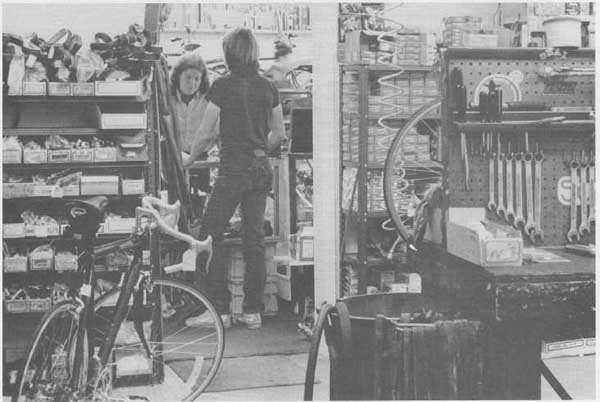
above: The full-service bike shop backs up its products with a well-equipped
workshop, a full stock of spare parts, and trained mechanics. This is the place
to buy a bicycle.
Some bike shops offer better service than others. Talk with other bicyclists and visit three or four shops before you make your final decision. Typically, the differences among shops are more important than the differences among the brands of bicycles they sell. Bike shops, like car dealerships, are highly competitive. Bicycles and accessories can be heavily discounted, especially in the off-season; comparison shopping may turn up some unusually good deals.
Custom-made Bicycles
It’s possible to have a bicycle made to order like a suit of clothes. Needless to say, the price is high— typically $600 and up—but it’s often justified, whether for a racer or a tourist. Ready-made bikes are pro portioned for average customers, and there are many people who need a custom bike simply for comfort.
Custom bikes are built by frame-building shops. Try to find one close enough to visit. You are more likely to get the exact bike you need if the frame-builder can measure you and talk about your needs with you.
Used Bikes and Used Parts
If you are looking for a bargain in a bike, the best approach is to buy a used bike. A bike shop is a good place to buy one. A rebuilt and guaranteed used bike will probably be as trouble-free as a new bike: Bike shop overhauls are often better than factory assembly.
If, on the other hand, you buy a used bike from a private party, you usually cannot count on its being well maintained or in good adjustment. Add the cost of an overhaul to the purchase price. Sometimes you can assemble a complete bicycle from parts of two or more damaged or incomplete bicycles. Used bicycles can be found at yard sales and through classified ads, and many are real bargains even counting the overhaul. Others are not worth fixing up, so have an experienced bicyclist pass judgment before you put down your money.
Scavenging parts is a valuable way to put together useful types of bikes which you would have trouble finding in a store. For example, you could install a fixed-gear track hub on a road bike. This combination gives great sensitivity to the road surface, and so is excellent for winter riding.
Another useful combination is a three- or five-speed internal hub on a lightweight bike for fast riding in the city. Internally geared hubs are usually sold on bikes with heavy steel wheels. but there is no reason that you can’t mix and match to suit yourself. In this way you can assemble a custom bike yourself—once you have mastered the assembly procedures described in this book.
JUDGING QUALITY
Two bicycles with $200 difference in price might appear to have the same type of equipment at first glance and, therefore, present a puzzling question:
Why such a great difference in price? The answer is in quality of the construction, the finishing techniques, and the components attached to the frame. Close inspection and attention to workmanship, along with a knowledge of name-brand derailleurs, pedals, hanger sets, and brakes, is necessary to determine how well the figure on the price tag reflects the true value of the bicycle.
When judging a bicycle, look first at the frame. Better frames have reinforced joints: Either the line of one frame tube should flow into another with a rounded, smooth contour, or there should be a reinforcing sleeve (called a lug) over the joint. Cheap frames have one tube crudely welded to the other, and often break apart in a minor accident or heavy use. Good frames do not.
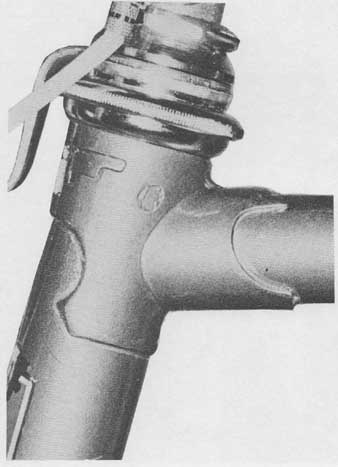
This good-quality bicycle frame has its tubes fitted into reinforcing
sleeves, called lugs, then brazed.
The frame tubes that hold the rear wheel are under the most stress at their forward ends, near the saddle and cranks. In better frames, these tubes are tapered—larger near the saddle and cranks and smaller where they meet at the hub of the rear wheel. On cheaper frames, these tubes will be untapered and may be squashed flat against the sides of the drop outs—the metal plates which hold the ends of the hub axle. On better frames, the tubes will have rounded ends at the dropouts.
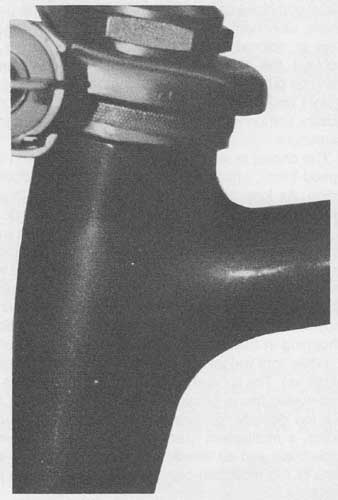
Another method of high-quality construction reinforces the brazed or
welded joints of the frame by building them up into rounded contours.
Better frames are lighter, yet stronger, because of better materials and construction. rarely find a bike shop selling a bike with a poor frame, because the frame is the most difficult part of the bike to replace.
Be especially sure that the frame fits you. There is much more to correct fit than being able to stand over the bicycle. To inform yourself, read section 2 before you go shopping.
Women have to shop carefully for a bicycle that fits; most frames are still proportioned for men, whose arms are relatively longer and legs shorter. Ironically, “mixte” or “ladies’” bicycle frames are likely to have a longer reach to the handlebars than diamond (“men’s”) frames; demand for diamond frames is greater, in creasing design flexibility. Most women who tour or race on bicycles use diamond frames anyway; “la dies’” frames offer few important advantages.
The frame is the only part usually made by the company whose brand name is on the bike—Univega, Raleigh, Lotus, Fuji, Schwinn, etc. Components such as hubs, rims, crank, chain, and saddle are made by outside suppliers. Bicycles are unlike other consumer products in that different manufacturers may have models equipped with the same components. The best buy may depend on which shop has better service.
The largely interchangeable, “generic” character of bicycle parts works to your advantage in another way as well: Unlike most other consumer products, bicycles usually don’t become obsolete because of un availability of spare parts. Many different brands of parts will fit your bike, so any good bike shop can service it—not just a dealer who sells the same brand. A knowledgeable bicyclist may even scavenge usable parts from worn-out or damaged bikes to save on repair bills.
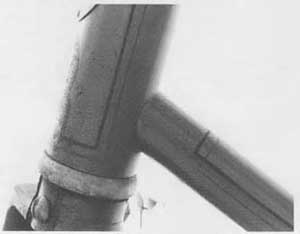
A frame with sharp contours at the joints and no lugs will generally
be both heavier and weaker than a reinforced frame.
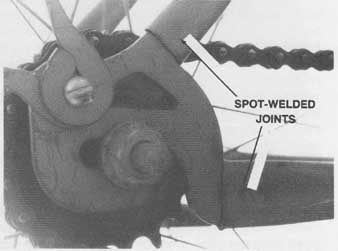
Stays (rear frame tubes) flattened against the fork-ends and spot- welded
in place are another sign of a low-quality frame.
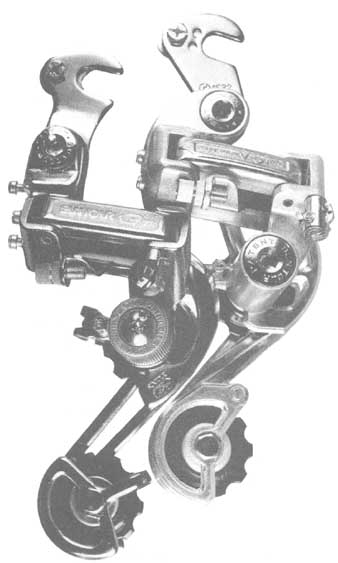
Steel vs. aluminum. Note the pearly gloss and bulkier contours of the
derailleur on the right, and the high gloss and “bent and folded” appearance
of the one on the left. Their performance is almost identical, but the all-steel
one weighs nearly twice as much.
Also, it’s simple to replace parts which don’t suit you. Many bike shops will make substitutions on new bikes at a low cost. For example, if your new bike does not have low enough gears or if the saddle is un comfortable for you, the shop can easily correct these problems.
Make sure that the components on your bike are of known name brands and can be serviced easily. If ever there was a time when you needed to put your trust in a name-brand item, it’s now. The manufacturers of quality items installed on the finest machines, both domestic and imported, have built their business and reputation on quality and performance. Winners of the Grand Prix races held throughout Europe and at the Olympic games have relied on those components which have given them the edge over competition. The tried-and- true bicycle components of reputable brand names like SunTour, Sugino. TA. Weinmann. Dia-ComDe. Stronglight, Campagnolo, and Shimano can be repaired easily; bike shops carry spare parts for major brands. Off- brand components, most commonly seen on cheaper bikes, come and go from year to year, and spare parts are not available.
Components of fine quality may be made of either steel or aluminum (called “alloy” by bicyclists). Identify steel components by their mirror-like chrome-plated finish; aluminum components, by their softer, pearly- gray or colored finish and their bulkier contours. To achieve the same strength, aluminum components must be bulkier, but they are nonetheless lighter. Light weight makes a bike more fun to ride, so most good- quality components for multispeed bikes use a lot of aluminum.
The choice is not so clear on three-speed and one- speed bikes, which are not intended for long-distance riding. As long as you stick with brands sold through bike shops, good steel components are common.
Aluminum offers the greatest advantage in the wheel rims, where its light weight increases maneuverability and acceleration. Brakes work much better in wet weather on aluminum rims. Generally, bikes with aluminum rims cost $225 or more new, but if you are buying a bicycle for more than occasional use, you should be shopping in this quality range anyway.
While light weight is an advantage, it can be taken to extremes. The lightest bikes, with 1-inch-wide tires and thin-walled frame tubing, are fine for racers, but they are too delicate for general use. For touring or utility riding, a multispeed road bike should have 1 1/4-inch- wide tires; and as mentioned earlier, the 2-inch-wide tires of the mountain bike are best for riding on poor surfaces.
Maintaining Your Bicycle
No matter what kind of bicycle you buy, it will need regular attention to maintain its safety and performance. Tires need pumping once a week, and there are a number of other minor adjustments that need regular attention. Every bicyclist is wise to learn how to fix a flat tire and perform other minor on-the-road repairs. This guide can teach you not only how to perform this minor maintenance, but how to overhaul every part of your bicycle.
ACCESSORIES
It’s a very common mistake to buy only a bicycle without the accessories which are needed to use it well. Plan on spending at least $100 on accessories. Every bicyclist needs the first few accessories in the following list; you may or may not need the remaining ones, depending on the conditions under which you will ride.
Helmet
Seventy-five percent of fatal and permanent injuries in bicycle accidents are head injuries. A hard-shell helmet, as now used by the majority of regular bicycle users and required by national bicycle racing organizations, will prevent most head injuries. Several brands are available. Make sure that the helmet you buy con forms to the ANSI (American National Standards Institute) standards for protection.
A small rear-view mirror which clips to the helmet is the most effective type for bicycling. No mirror, whether on a car or a bicycle, substitutes for a look over the shoulder; but with a bit of practice in its use, the mirror can be helpful in many situations.
Tool Kit
Expect to spend about $20 for a small tool kit as described in section 4. The kit should include an adjustable wrench, screwdriver, spoke wrench, air- pressure gauge, tire-patch kit, tire irons, and carrying pouch. These tools will be adequate to fix a flat tire and perform most other on-the-road repairs.
Pump
You’ll need this to inflate a tire you’ve patched, and to top up tire pressure, a weekly chore. Buy a small pump which clips to the bicycle frame. The best type has a locking head to secure it to the tire valve. A pump which connects to the tire with a small hose is more difficult to use.
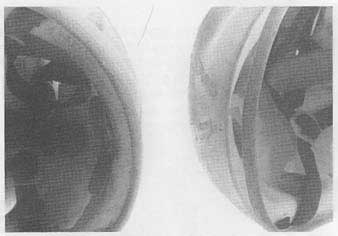
The helmet on the right saved a life. When a stick jammed his front
wheel, the owner landed full-force on the front of the helmet. Note the crushed-down
foam liner of the helmet, and the deep scratches on the outside. The owner
went back to work the next day.
Gloves
In cold weather, you’ll wear ordinary winter gloves. In warm weather, fingerless bicyclist’s gloves cushion your hands while you ride and prevent skinned palms when you take a fall. Gloves typically cost $10 to $25.
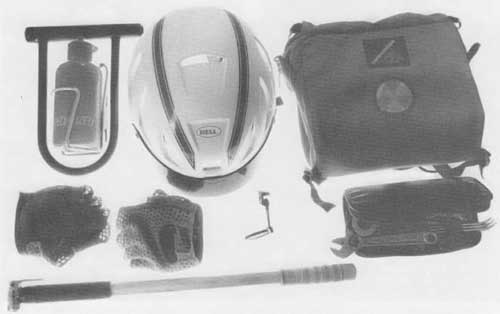
Accessories every bicyclist should have: U-lock, water bottle, helmet
(with optional mirror), handlebar bag, tool kit, pump, gloves.
Lock
A bicycle is a prime target for theft, since it’s its own getaway vehicle. Buy one of the large U-shaped locks sold at bike shops. Use it correctly to secure the rear wheel and frame; with a front quick-release hub, it can secure the front wheel as well.
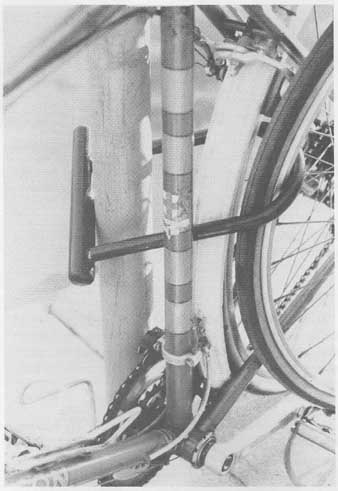
Used as shown, the U-lock secures the frame, rear wheel, and quick-release
front wheel. The lock may optionally pass around the seat tube if it reaches.
The most common error is to secure only the frame, or one wheel.
Water Bottle
On a trip of ten or more miles, you need to drink water to replenish moisture lost through perspiration. A bicycle water bottle in its frame-mounted cage lets you do this conveniently without stopping.
Bags and Racks
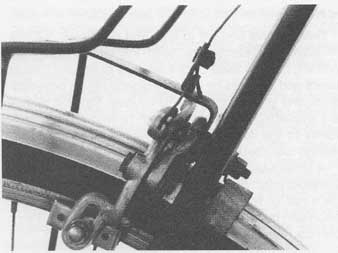
Accessories such as the rack and fender here may be attached at the
brake bolt. Make sure that the bolt is properly secured, and that the accessories
don’t interfere with the operation of the brake.
For comfort and safety, attach baggage to the bicycle, not to yourself. For casual riding, you could use a small backpack; more convenient is a small handlebar bag with a top map case. If you go shopping or camping on your bike, you will need a baggage rack. Better racks clamp to the brake bolt or use eyelets which grip the frame tubes above the rear wheel; avoid the type that clamps the frame tubes between two flat plates of metal. Pannier bags that attach to a front or rear rack are available to carry large loads. Buy a couple of bungee cords (rubber stretch straps) to secure loose objects to the top of the rack.
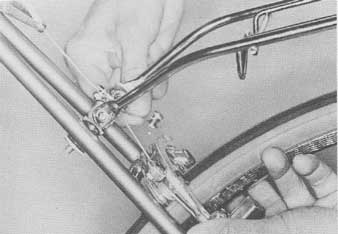
Avoid rear racks which are attached as shown here, by clamping two
plates against the seatstays. These racks tend to be unstable.
Lights and Reflective Equipment
Most bicycles are sold with reflectors, but these only make you visible to drivers whose headlights happen to be pointed at you—not to pedestrians, other bicyclists, or drivers approaching in side streets ahead of you. A white headlight and red rear reflector or taillight are required by law for night riding, and even when riding under streetlights you need them to be seen.
Generator lights are the most practical for all-around use. They are the only kind that make sense for tours of several days in areas where batteries may not be available. The better generator headlamps are bright enough for riding on unlighted roads.
Small battery-powered lamps are suitable for city riding under streetlights—not bright enough to light your way, yet bright enough so you can be seen. Aim both the front and rear lamps level if they are of this type. If you use these lights often, you will save money by equipping them with nickel-cadmium rechargeable batteries, available at any hardware store.
High-powered battery lighting systems are available at a higher cost. These are by far the best type of lights for commuting where there are no streetlights.
Since a taillight bulb can burn out without your knowledge, you should always use rear-facing reflectors too. Those in a typical new-bike set are not as bright as they ought to be. A larger rear reflector is a good idea, as well as a reflective vest, pedal reflectors, tape on the frame and helmet, and ankle bands.
Fenders
Fenders are necessary to protect you and the bike from tire splash in wet weather. Some bikes come equipped with fenders, and they can be added to any bike except an all-out racing bike. To keep your feet dry, the front fender should have a mud-flap which extends nearly to the ground. You can make one easily by cutting out one corner of a plastic milk carton and bolting it onto the rear of the fender. Cloth toeclip covers also help keep your feet dry.
Rainwear
In anything short of a downpour, appropriate rain wear will keep you dry and comfortable. Bicyclists use a rain cape, like a poncho but tailored to fit you in riding position; it has loops which you place over your thumbs or the brake levers to extend the front. A conventional camper’s poncho is not suitable: It will flap in the wind or catch in the spokes.
A Gore-Tex rainsuit is usable for bicycling, though steamy in warm weather and expensive—about $120. A rainsuit of coated nylon or rubber will soak you in condensed perspiration; you will get as wet as if you had let the rain fall on you.
Unless you wear glasses, goggles are a good idea to keep stinging raindrops out of your eyes.
Clothing and Shoes
You can ride a bicycle in ordinary clothing—tuck your trouser cuffs into your socks to keep the chain from soiling them—but special clothing has real advantages if you ride much.
A bicycle jersey is cut long so you won’t get a patch of sunburn on your lower back from leaning over the handlebars. It fits snugly so the wind can’t blow it around. The pockets are in the back, where their con tents are held steady against your body. Bicycle jerseys typically are dyed in bright colors, which in crease your visibility and safety.
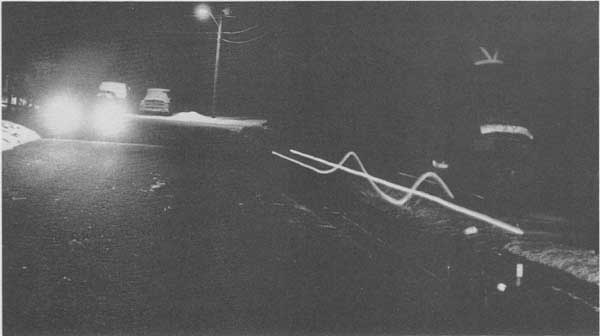
Lights and reflectors are required for safe and legal night riding.
Streaks in this time exposure are from a steady taillight and the up-and-down
motion of a leg light. Reflectors on the rear fender, pedals, vest, and helmet
are revealed by the camera’s flash.
Bicycle shorts are cut long, and fit snugly around the legs so they won’t ride up. Seams are carefully stitched so they won’t chafe you. The shorts are black, to hide marks from the chain and the saddle. Inside the shorts is a soft chamois or terry-cloth liner to ease the pres sure of the saddle. For maximum comfort, the shorts are worn without underwear.
For cooler weather, a long-sleeved jacket and tights (like shorts, but with long legs) keep you warm. For very cold weather, you should dress like a cross- country skier, with windproof, lined mittens, shoe covers—or two pairs of socks—an insulated face mask, and several light layers of clothing which you can add or remove as necessary. With proper clothing, there’s no problem with riding in temperatures well below freezing.
Wool, wool blends, and polypropylene are preferred materials for jerseys, shorts, and tights. Because of their water-resistant properties, they keep you cool in hot weather and warm in cool weather.
Bicycle shoes are lightweight, with stiff soles to spread the load from the pedals; the uppers are rein forced to resist wear from toe-straps. Some shoes are intended to be used with slotted cleats, others without.
With toeclips and straps, cleats fasten your feet more securely to the pedals and improve efficiency, especially in climbing, though they are an annoyance if you must get off the bike frequently. Fortunately, many designs of bicycle touring shoes without cleats are now available, and serve their purpose well. As this is writ ten, new, cleatless locking shoe-pedal systems are just beginning to reach the market.
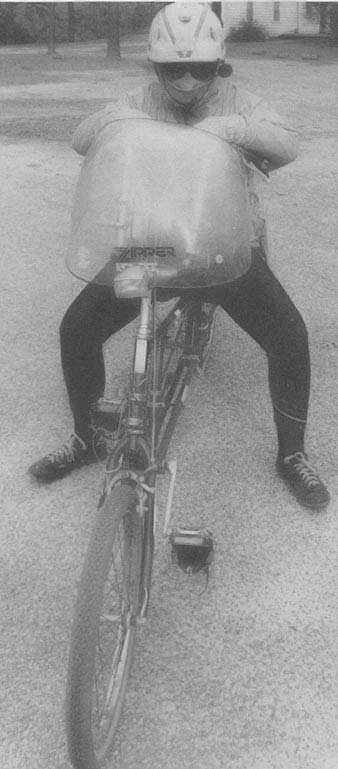 As this recumbent rider demonstrates, cold-weather riding is practical
with the correct clothing: heavy gloves, wool cap under the helmet, and layers
of clothing like a cross-country skier’s. The face mask and windshield further
aid comfort in cold weather.
As this recumbent rider demonstrates, cold-weather riding is practical
with the correct clothing: heavy gloves, wool cap under the helmet, and layers
of clothing like a cross-country skier’s. The face mask and windshield further
aid comfort in cold weather.
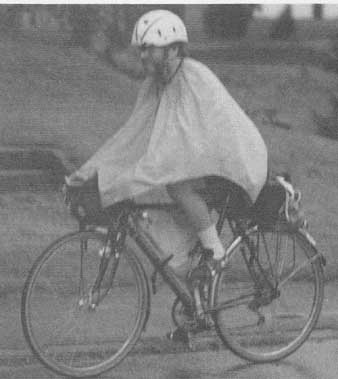
Comfortable riding in wet weather requires a rain cape and fenders,
as shown.
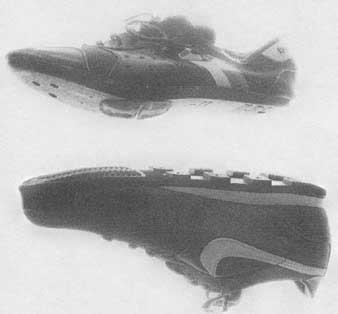
The upper shoe is cleated; the lower shoe, for touring, has a stiff
sole with a rubber traction surface for the pedals.
INSTALLING ACCESSORIES
Fenders, racks, and generator lights must be bolted to the frame of the bicycle. There are too many different kinds to describe the installation of all of them here. Have the bike shop install accessories on a new bike, or follow the instructions supplied with them. Be careful to tighten nuts and bolts carefully, especially those which also hold the brakes in place. If you are not yet experienced in mechanical work, it’s a good idea to have a mechanic install accessories for you.
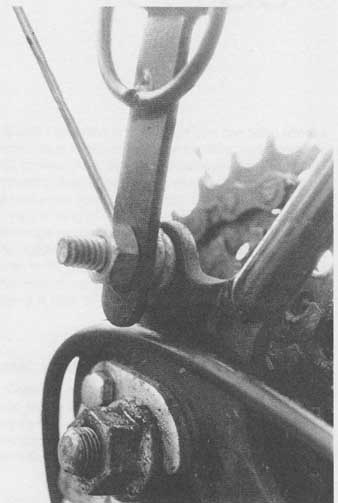
Where the fender and rack braces attach to the frame at the eyelets
of the forkend, they must be tightly secured.
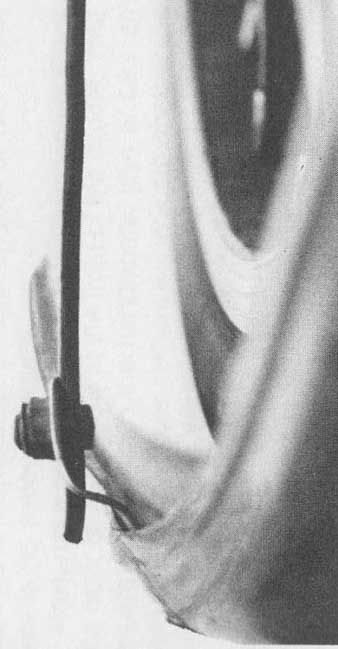
above: Fender braces should be passed through the eyebolt and cut short, not
bent over.
LIGHT
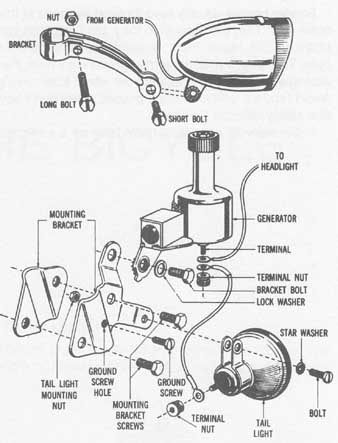
Exploded view of a typical tire-sidewall generator lighting system.
The front and rear lamps are wired to the generator, but the electrical return
path is through the frame, requiring the ground screw to establish electrical
contact. Running a second, ground wire between the generator and lamp brackets
increases reliability.
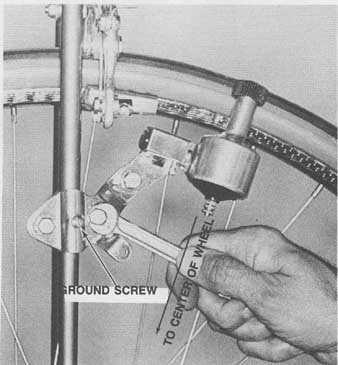
To prevent excess tire wear, the centerline of the generator must intersect
with that of the wheel axle.
Fender braces usually feed through eyebolts at their outer end. Trim the braces so they can’t catch on your clothing, but leave them straight—don’t bend them over. This way, if a fender jams against the wheel, it will disengage rather than stopping the wheel from turning. Avoid fenders with U-shaped braces: They don’t have this safety-release feature.
A tire-sidewall generator must bear on a surface of the tire which is coated with rubber. Sidewalls of light weight tires are too thin, so tilt the generator up to run on the side of the tread. The center of the roller surface should contact the tire, and the generator’s axis should point exactly toward a line extended from the end of the wheel’s axle, or the generator roller will wear the tire. A front-wheel generator must always be ahead of the fork, to lessen the chance of its tangling in the spokes.
++++++++++